
Art | Resources
Is It Toxic to Eat Off Depression Glass?
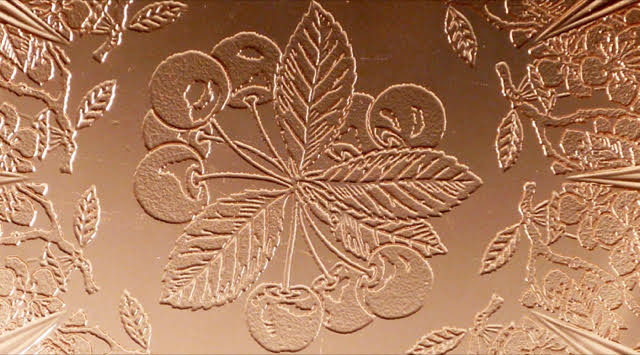
Question from TA
Hi Debra,
I’m wondering if you’ve ever looked into whether “Depression glass” is toxic to eat off of.
I have a set that was gifted to me years ago; it was a collection that was built up over time, just as a collection, not for actual use.
I am now wondering whether it is okay to eat off of, so I just did an internet search and feel unclear about the answer.
The answers from people who sell and collect depression glass is that it is safe; they mention uranium in some colors, arsenic in others…but it’s safe they say because it’s a tiny amount, it’s bound up in the matrix of the glass, and so forth.
Hmm. That also doesn’t really answer anything about my actual collection, which is pink.
But what concerns me more is whether there is lead in it. I found some info about there being two options in depression glass production — one containing lead and one not (but this no-lead option might have contained other undesirable ingredients).
Of course I would avoid lead crystal, but that doesn’t appear to be what they’re talking about in some instances, and it’s not clear to me whether other colors might have also contained lead to add to the clarity of the glass.
So overall it left me confused, and I just wondered if you’ve looked into this and can tell me anything definitive.
I don’t want to trash it without knowing anything for sure, given that it was a gift and it’s lovely to look at. But of course I don’t want to eat off of it — or donate it to Goodwill or sell it — if it contains lead or is otherwise harmful. If it were one cheap saucer or something I’d just throw it out (I’ve generally done that when it’s something I’m not sure about and don’t want to send it to Goodwill to lead-poison someone else’s child); but it’s a whole set and a collectible, so I’d rather know something before just getting rid of it.
Debra’s Answer
My general rule is when in doubt, err on the side of caution.
It may be true that there is so little uranium or arsenic in the glass that it’s not a problem. But the other side of the coin is not a problem for who? Age and body size can make a difference in how toxic it is to an individual person as well as the condition of their detox system and the health of their body as a whole.
Short of having the pieces analyzed for their content, we really don’t know if the glass contains something to be concerned about.
We do know from lead crystal that minerals can leach out of glass into food and then into bodies when the food is eaten.
Myself, I wouldn’t eat off depression glass, but wouldn’t have a problem keeping it to enjoy it’s beauty.
Crystal Vases and Bowls
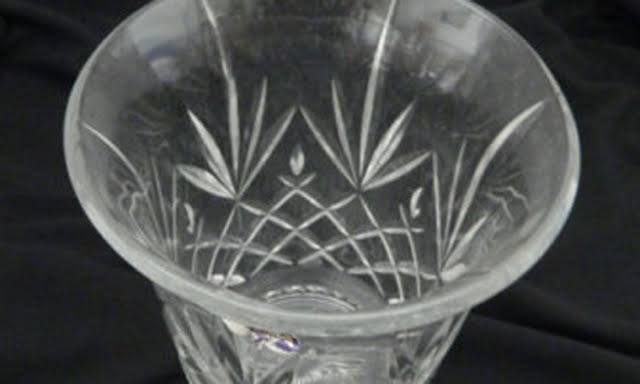
Question from TA
Hi Debra,
I know that lead crystal is harmful in that one shouldn’t eat or drink from it. But is there any concern about having it in the house in general?
For instance, if there is a vase or decorative bowl, could a person end up with lead on their hands from handling it, or could dust end up with lead in it?
I know that this can happen if a person is handling dishware that has lead glaze, for example, but I’m wondering if it’s the same for something like lead crystal, or is the lead more embedded or something, so that it doesn’t transfer?
I have some that was gifted to me years ago, and it isn’t really in use in my home so I thought of giving it away or selling it as part of a decluttering process. But similar to my other question about depression glass , I don’t want to give away or sell something that could be harmful to another household; but if it’s safe for general use (decorative, really), I’d rather give or sell rather than throw it out.
I also have a set of crystal candlestick holders for taper candles; those could potentially end up on someone’s dinner table which makes the question more important. Of course, I really don’t know what the end use would be if I did sell it, so perhaps it is better to just throw it out so that no one could be unknowingly poisoned if they aren’t aware of the issues (if there is in fact an issue with this type of decorative items). I just hate to throw out a beautiful heavy vase and these other items if it’s safe to use them for those purposes.
Debra’s Answer
Lead is a particle and it does not outgas from glass in the same way a vapor outgassed from plastic. So lead crystal sitting on a table has no danger at all.
Also, you can handle lead and it is not absorbed through the skin.
But lead does leach out of glass into liquids and foods, then you can be exposed to lead through eating the food or drinking the liquid.
There are other exposures to lead, but this is the answer to your specific question.
Craft Beer Brewers Consider the Effects of Beermaking
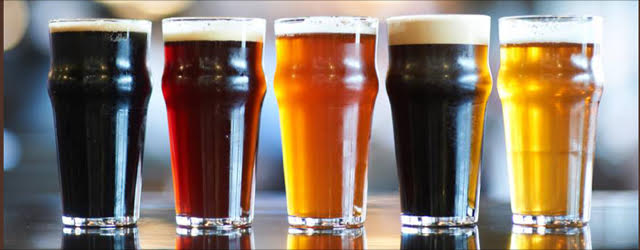
I read an interesting article about how and why craft beer brewers are finding “innovative ways to guard the water, soil, air and climate on which their businesses depend.”
Well, right there is something different than usual. We don’t often see the producers of products consider the environment on which their businesses depend. If this were common, our environment would be pristine.
Katie Wallace, assistant director of sustainability at the New Belgium Brewing Company says, “I ride my bike across the bridge every morning to the brewery. Underneath that bridge is the river that provides the water for our beer. We’re very connected to the resources that provide for us.”
This article outlines many things craft brewers are doing to protect the integrity of the environment from which their ingredients come. This is a great example for all industries.
New Study Shows People Would Buy Green Products—If They Had Enough Information

A new study, published in the Proceedings of the National Academy of Sciences, notes that Internet-based companies have the opportunity to help the environment if they would just tell consumers about their environmentally friendly choices.
Researchers found that consumers are willing to make climate-friendly choices when the options are available to them. Carbon footprints of products and services are often known to companies, but are not made known to consumers.
In experiment after experiment, consumers chose the green products when the information on the products was available to them.
I’m posting this study here because the same applies to companies providing information to consumers about how toxic or nontoxic their products are.
I just am having an experience this week with a website that is selling a product that appears to be nontoxic but there are no ingredients. An email asking directly for the ingredients produced a reply, but no mention of ingredients.
It shouldn’t be that hard to get information about products. This study shows that consumers are interested in having information so they can make informed choices.
THE WASHINGTON POST: People would buy green products – if only e-commerce showed them how
Stubby Pencil Studio
 “Looking for the most safe, non-toxic and creative art supplies for kids? Here’s where you start!…We have a passion and commitment to sourcing non-toxic art supplies for children…a wide selection of art materials that are healthy for children, toddlers, families and the environment…biodegradable crayons made from soy (not petroleum), sketchbooks made from 100% post-consumer recycled paper (not virgin trees), pencils made from sustainably harvested wood and recycled newspapers (not dying forests), natural paints made from fruits & veggies, and more… “ They have crayons, chalk, clay and dough, colored pencils, paints, markers, rubber stamps and ink, paste and glue, and more. But read descriptions carefully and choose wisely. Their criteria is nontoxic OR eco-friendly, so scented pencils made from recycled newspapers qualify, but I don’t recommend the artificial fragrance. Lots of nontoxic art supplies though, all in one place.
“Looking for the most safe, non-toxic and creative art supplies for kids? Here’s where you start!…We have a passion and commitment to sourcing non-toxic art supplies for children…a wide selection of art materials that are healthy for children, toddlers, families and the environment…biodegradable crayons made from soy (not petroleum), sketchbooks made from 100% post-consumer recycled paper (not virgin trees), pencils made from sustainably harvested wood and recycled newspapers (not dying forests), natural paints made from fruits & veggies, and more… “ They have crayons, chalk, clay and dough, colored pencils, paints, markers, rubber stamps and ink, paste and glue, and more. But read descriptions carefully and choose wisely. Their criteria is nontoxic OR eco-friendly, so scented pencils made from recycled newspapers qualify, but I don’t recommend the artificial fragrance. Lots of nontoxic art supplies though, all in one place.
Fabricadabra
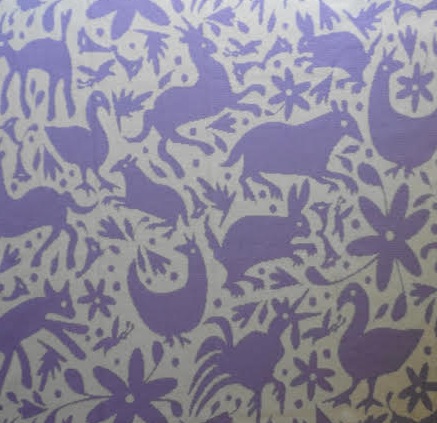 This is basically a pillow website, but they also sell fabric by the yard, throws and bedcovers, pillow inserts, and floor cushions. “…made only from natural, non-toxic fabrics. Globally inspired throw pillows include ikats, suzanis, wax prints, organic cotton, vintage, batiks, indigo cloth and tie-dyes. The fabrics are woven only from natural, non-toxic fibers, using mostly ancient techniques and low impact dyes. A story, a person and a culture are behind every fiber. Most decorative pillow cover fabrics are woven on handlooms and the artisans are paid fair wages for their skills. Decorative pillow inserts are made with kapok fiber filling and organic cotton shells. Kapok fiber is natural, organic, pesticide free, non-allergenic, mold and mildew resistant, lightweight, odorless, silky, sustainable, washable and non-toxic. All inserts are made in the U.S.A.” And I have to mention colorful vintage sari parasols that are a must if you live in a sunny climate. This site is ALL about natural fiber fabrics and doing creative things with them.
This is basically a pillow website, but they also sell fabric by the yard, throws and bedcovers, pillow inserts, and floor cushions. “…made only from natural, non-toxic fabrics. Globally inspired throw pillows include ikats, suzanis, wax prints, organic cotton, vintage, batiks, indigo cloth and tie-dyes. The fabrics are woven only from natural, non-toxic fibers, using mostly ancient techniques and low impact dyes. A story, a person and a culture are behind every fiber. Most decorative pillow cover fabrics are woven on handlooms and the artisans are paid fair wages for their skills. Decorative pillow inserts are made with kapok fiber filling and organic cotton shells. Kapok fiber is natural, organic, pesticide free, non-allergenic, mold and mildew resistant, lightweight, odorless, silky, sustainable, washable and non-toxic. All inserts are made in the U.S.A.” And I have to mention colorful vintage sari parasols that are a must if you live in a sunny climate. This site is ALL about natural fiber fabrics and doing creative things with them.
Moon Spoons
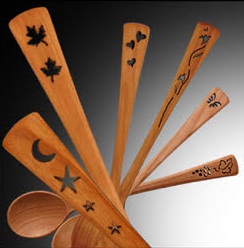 I first found MoonSpoons in a handmade crafts store and bought one of their wooden tongs because I love the nature-inspired designs: stars, the moon, leaves, flowers and more. Their new line features designs based in architectural elements. Their spoons and other utensils are made in Kempton PA of solid cherry wood native to Pennsylvania, New York, and New Jersey. They “finish” their utensils with a food grade mineral oil but spoons can also be purchased “unfinished”.
I first found MoonSpoons in a handmade crafts store and bought one of their wooden tongs because I love the nature-inspired designs: stars, the moon, leaves, flowers and more. Their new line features designs based in architectural elements. Their spoons and other utensils are made in Kempton PA of solid cherry wood native to Pennsylvania, New York, and New Jersey. They “finish” their utensils with a food grade mineral oil but spoons can also be purchased “unfinished”.
Allegheny Treenware
 A large selection of wooden kitchen utensils for everyday use. “All products are MADE IN THE USA, with quality West Virginia hardwoods that, if taken care of, will serve your cooking needs for years to come. Spoons, measuring cups and spoons, forks, knives ,strainers, flippers, serving utensils, spreaders, stirrers, salad utensils, tongs, and much more. Good, sturdy, simple, useful designs.
A large selection of wooden kitchen utensils for everyday use. “All products are MADE IN THE USA, with quality West Virginia hardwoods that, if taken care of, will serve your cooking needs for years to come. Spoons, measuring cups and spoons, forks, knives ,strainers, flippers, serving utensils, spreaders, stirrers, salad utensils, tongs, and much more. Good, sturdy, simple, useful designs.
Naked Botanicals Apothecary
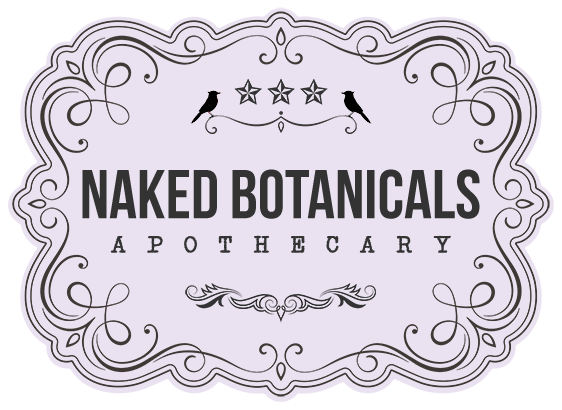 Insect repellent made from organic ingredients, “field-tested to repel mosquitoes, ticks and biting insects for up to 4-8 hours YET FEELS LIKE YOU’RE WEARING NOTHING. We take a bold, citrus bouquet of lemongrass, citronella plus energizing peppermint then round it out with woody lavender and cedarwood notes to create a naturally-occurring insect repellent in a signature intoxicating scent. Yum.Not only does it create a Cloak of Invisibility against biting insects, but the witch hazel-based elixir also refreshes and purifies your skin in high heat and humidity. ”
Insect repellent made from organic ingredients, “field-tested to repel mosquitoes, ticks and biting insects for up to 4-8 hours YET FEELS LIKE YOU’RE WEARING NOTHING. We take a bold, citrus bouquet of lemongrass, citronella plus energizing peppermint then round it out with woody lavender and cedarwood notes to create a naturally-occurring insect repellent in a signature intoxicating scent. Yum.Not only does it create a Cloak of Invisibility against biting insects, but the witch hazel-based elixir also refreshes and purifies your skin in high heat and humidity. ”
Ancient Organics
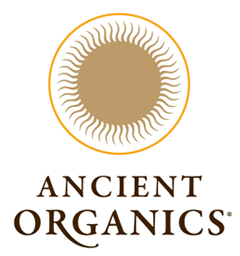 Ghee “unlike any other you will find on the market today. We take great care and consideration in the ingredient selection and preparation method.” Small batches cooked over an open flame, produced in a peaceful and mantra-infused kitchen, made under the influence of the bright and waxing moon to amplify the elemental healing qualities and taste of ghee. “We make our ghee from the unique dairy of Northern California. The native wildflowers and sweet grasses of the coastal prairie provide a terroir unlike any other part of America. We are committed to sourcing our dairy from the grass fed and pastured cows of this region. We produce each and every month to highlight the changes in pasture as reflected in the cows diet and celebrate the seasonal changes in the butter and ultimately our ghee.”
Ghee “unlike any other you will find on the market today. We take great care and consideration in the ingredient selection and preparation method.” Small batches cooked over an open flame, produced in a peaceful and mantra-infused kitchen, made under the influence of the bright and waxing moon to amplify the elemental healing qualities and taste of ghee. “We make our ghee from the unique dairy of Northern California. The native wildflowers and sweet grasses of the coastal prairie provide a terroir unlike any other part of America. We are committed to sourcing our dairy from the grass fed and pastured cows of this region. We produce each and every month to highlight the changes in pasture as reflected in the cows diet and celebrate the seasonal changes in the butter and ultimately our ghee.”






